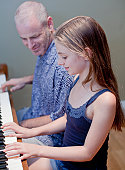
Home > Piano Techniques > Thrills And Tremolo
|
||||
Piano Thrills And Tremolo Technique
Some of these elements – like the fluttering of a bird’s wing, the blowing of wind, the trembling of an earthquake, or the shaking of a nervous hand – are imitated in music using unique techniques called trills and tremolos. These sounds are actually relatively easier to produce on piano than on other instruments, but that does not make them easy. Piano trills and tremolos are among one of the more unique and flexible sounds in music, and it is important that pianists are aware of the appropriate technique to perform them. In this free piano lesson, we are going to show you how. A trill on the piano is sound produced when a player rapidly alternates striking two keys. For example, he may play D and E very quickly, switching between the two notes for a specified duration. Normally, the trill is played by using the second and third finger. These two fingers are the hand’s strongest (aside from the awkward thumb) and are therefore the best two for performing this skill; however, there are many instances (like is Beethoven’s Waldstein Sonata) when the situation requires two other fingers to produce the trill. While it is extremely different to make a trill with weaker fingers, enough training at this technique will build muscle and make this entirely possible. Trills are normally noted in music by drawing a waving line horizontally above a note or writing the letters tr above a note. This means that whichever note has this line above it, the appropriate notes to perform the trill on are the written note and the note on the same scale immediately above it.
If playing a trill on C and D, one could flourish the ending by quickly playing B, C, D. This technique is known as an appoggiatura. Trill lasts as long as the written note’s rhythm indicates, and frequently the waving line above it will stretch as long as its intended duration as well. Tremolos are similar to trills in that it is two notes rapidly alternating from one another, but in tremolos these notes are not immediately next to one another. While a trill might be played on notes C and D with the second and third fingers, a tremolo may be played on, say, C and G, with the thumb and pinky effective this succession. Any interval larger than a whole step qualifies as a tremolo. Normally, tremolos are noted differently than trills, too. Instead of a wavy line above the note, tremolos feature two notes spaced apart with three thick, straight lines connecting them. These three lines indicate that the performer should rapidly alternate between the two written notes for the duration that both notes’ rhythm indicates. So if a measure has a C and G written as two whole notes separated by three thick lines, then a tremolo should be played for the entire measure. Trills and tremolos can create unique effects that require the fingers to flutter in the same way that the musical effect flutters to the ear of the listener. Playing both of these skills requires different techniques, much speed, and impressive muscle control. However, like all other piano skills, piano trills and tremolos are obtainable with enough practice! This piano course lesson was brought to you by http://www.playpianotips.com/
http://pianoplayerworld.com/PianoImprovisationCourse.html
| ||||
|
Although every attempt has been made to make information as accurate as possible, we are not responsible for any errors that may appear.
 It’s amazing how music can capture through sound some of the extraordinary elements of
life we witness around us.
It’s amazing how music can capture through sound some of the extraordinary elements of
life we witness around us.
 So if a C has a wavy line or tr above it, that means to rapidly alternate playing
notes C and D. Sometimes it is appropriate for a note to end with a turn, or the playing of additional notes
that end the trill.
So if a C has a wavy line or tr above it, that means to rapidly alternate playing
notes C and D. Sometimes it is appropriate for a note to end with a turn, or the playing of additional notes
that end the trill.



